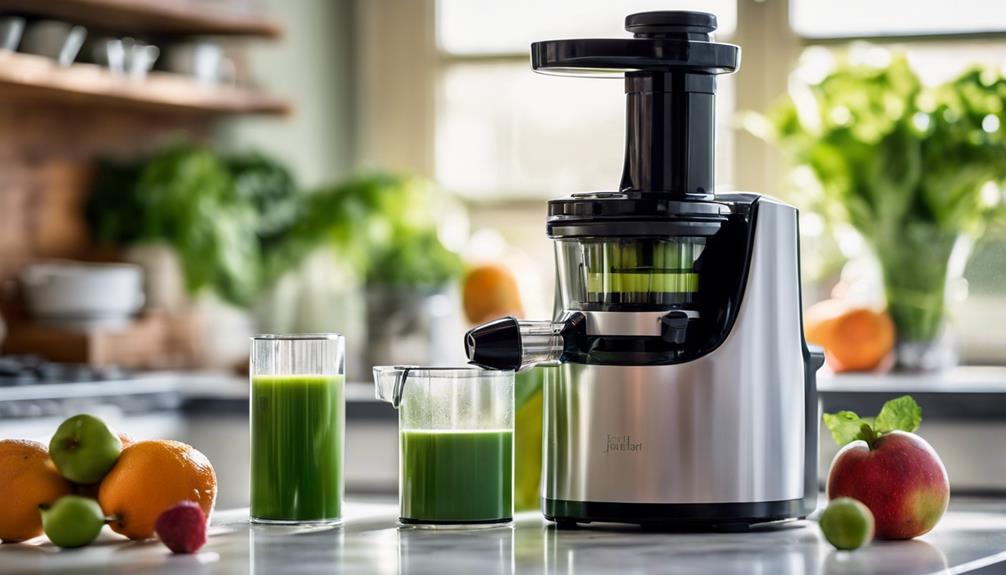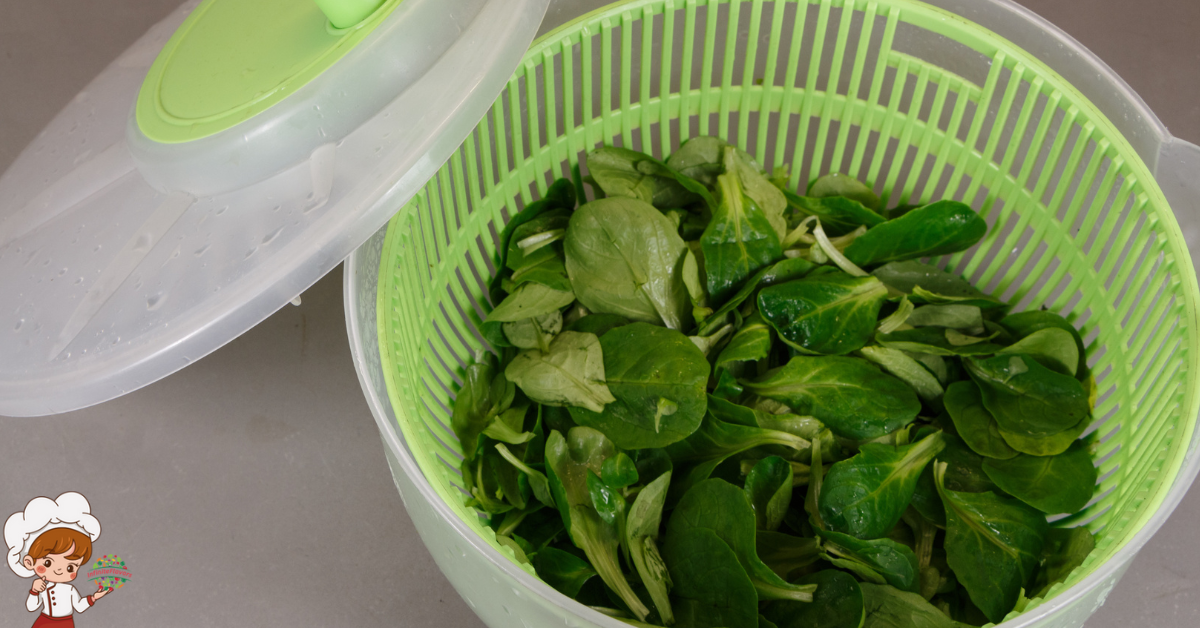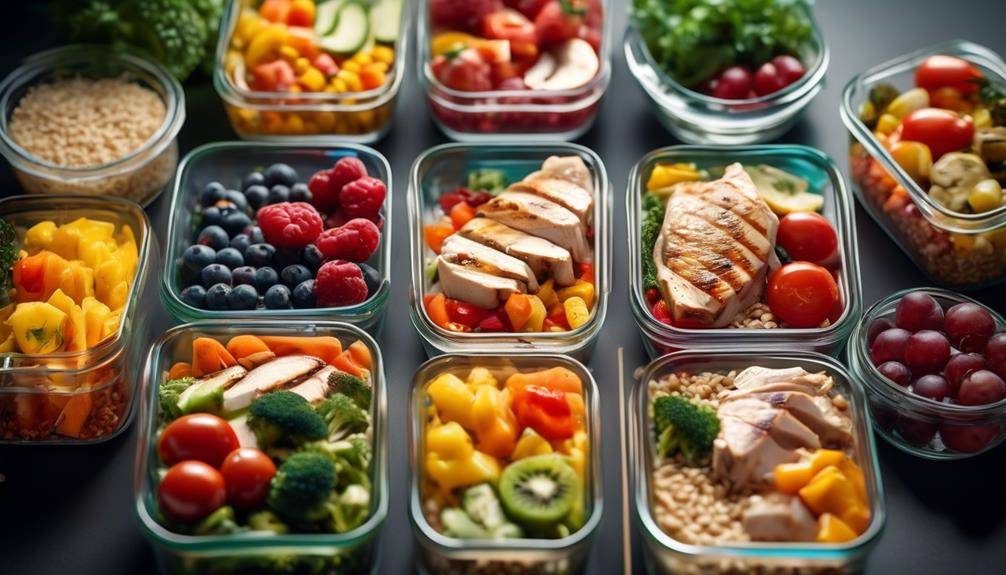The Best Slow Juicers For Nutrient Retention

If you want to maximize nutrient retention from your fruits and vegetables, a Slow Juicers For Nutrient Retention is your best bet. These juicers work at lower speeds, using an auger to crush and grind produce, which minimizes oxidation and heat generation. This process preserves vitamins, minerals, and enzymes essential for health, allowing you to enjoy higher juice quality and flavor. Slow juicers also yield more juice with drier pulp, enhancing your overall experience. Whether you’re looking for a way to boost your energy or improve your digestion, exploring the various types can help you find the perfect fit for your needs.
What Is a Slow Juicer?
A slow juicer, often referred to as a masticating juicer, operates at a lower speed compared to traditional centrifugal juicers. This slower speed helps preserve more nutrients and enzymes from fruits and vegetables, making it a popular choice for health-conscious individuals. You’ll find that the extraction process focuses on crushing and grinding, which minimizes oxidation and heat buildup. As a result, you get a juice that retains vibrant colors, fresh flavors, and essential vitamins.
When it comes to slow juicer types, you’ll encounter vertical and horizontal models. Vertical slow juicers are compact and easy to store, making them great for smaller kitchens. They typically have a single auger that extracts juice efficiently. Horizontal slow juicers, on the other hand, are wider and tend to offer greater versatility. They often come with multiple attachments, allowing you to create nut butters, sorbets, or even pasta.
Choosing the right slow juicer depends on your needs and preferences. You might prioritize ease of use and storage or seek a machine that offers more functionality. Regardless of the type you choose, you’ll enjoy several slow juicer benefits. These include better nutrient retention, improved juice yield, and less foam production. This means you not only get more juice but also a higher quality drink that’s packed with health benefits. Investing in a slow juicer can elevate your juicing experience while supporting your overall wellness journey.
Benefits of Slow Juicing
One major advantage of slow juicing is the enhanced nutrient retention it offers. This method extracts juice without the heat and oxidation that can occur with traditional juicers, allowing you to enjoy more vitamins and minerals in every sip. By incorporating slow-juiced beverages into your diet, you’ll experience a range of health benefits.
For starters, slow juices provide excellent digestive support due to their high fiber content, helping your body process nutrients more effectively. You’ll also notice an immune boost, as ingredients like leafy greens and citrus fruits are packed with antioxidants that strengthen your defenses. Plus, the energy enhancement from these nutrient-dense drinks can keep you feeling vibrant throughout the day.
If you’re focused on weight management, slow juicing can serve as a great meal replacement option. It’s a convenient way to stay full while consuming fewer calories. Another perk is the hydration sources you gain; fruits and vegetables contain high water content that keeps you hydrated and refreshed.
Moreover, slow juices can promote skin health. The nutrients and hydration can give your skin a radiant glow. You’ll also find detox benefits, as many ingredients assist in flushing out toxins from your body.
Lastly, slow juicing opens up a world of recipe inspiration. You can mix and match your favorite fruits and veggies to create unique blends tailored to your taste. Embrace the benefits of slow juicing and transform your health today!
Nutrient Retention Explained
While many people focus on the taste of juice, understanding nutrient retention is fundamental for maximizing its health benefits. Nutrient retention refers to how well the vitamins, minerals, and enzymes in your juice remain intact after extraction. If you’re aiming to get the most out of your fruits and vegetables, you need to take into account the factors that affect nutrient bioavailability.
When juicing, enzymatic activity plays a pivotal role in how your body absorbs nutrients. Enzymes help break down food compounds, making vitamins and minerals easier for your body to utilize. However, heat and exposure to air can diminish this activity, leading to a loss of valuable nutrients. This is where slow juicers shine. They operate at lower speeds, generating less heat and reducing oxidation, which helps preserve these essential enzymes and nutrients.
The way you process your juice can greatly impact its nutrient content. Unlike traditional high-speed juicers, slow juicers maintain a gentle extraction process that guarantees maximum nutrient retention. This means you’re not just drinking juice; you’re consuming a more nutrient-dense product that can provide your body with the important components it needs.
Ultimately, understanding nutrient retention is about making informed choices. By opting for a slow juicer, you’re prioritizing the preservation of nutrients, confirming that each glass of juice you enjoy contributes meaningfully to your overall health and well-being. So, when you sip that invigorating juice, know that you’re harnessing the full power of its nutrients.
How Slow Juicers Work
Understanding how slow juicers work reveals their unique design and functionality. Unlike traditional centrifugal juicers that rely on high-speed blades to shred produce, slow juicers operate at a much lower speed, typically around 40 to 100 RPM. This gentle process minimizes heat and oxidation, which helps preserve essential nutrients in your juice.
When you feed fruits and vegetables into a slow juicer, their unique auger mechanism slowly crushes and presses the ingredients. This method enhances juice extraction by breaking down the cellular structure of the produce, allowing for a more efficient yield. As the juicer works, it simultaneously separates the juice from the pulp. The extracted juice flows into a container, while the pulp is expelled through a separate outlet.
The slow juicing process not only maximizes the amount of juice you get but also maintains the vibrant flavors and colors of your ingredients. Plus, the pulp separation is key to creating a cleaner juice without unwanted fibrous materials. You’ll notice that slow juicers can handle a wide variety of produce, including leafy greens, hard vegetables, and even nuts for making nut milk.
Key Features to Consider
When selecting a slow juicer, you’ll want to contemplate several key features that can enhance your juicing experience. One of the primary factors is the juicer’s juice extraction techniques. Look for a model that utilizes masticating technology, as this process crushes fruits and vegetables more effectively, guaranteeing maximum nutrient retention and a richer flavor. Additionally, consider the juicer’s ability to handle a variety of ingredients, from leafy greens to hard root vegetables. A versatile machine can give you more options for nutritious blends.
Another vital aspect is juicer durability considerations. You should choose a juicer made from high-quality materials, as this impacts its lifespan and performance. Stainless steel components and BPA-free plastics are excellent choices that not only enhance durability but also promote safety in your kitchen. Moreover, think about the warranty provided by the manufacturer; a longer warranty often reflects the company’s confidence in its product.
Ease of cleaning is also a feature worth noting. A design that allows for quick disassembly and is dishwasher safe can save you time and hassle after juicing. Finally, noise levels can be a factor too; a quieter model might be more suitable if you plan to juice early in the morning or late at night.
Comparing Slow and Fast Juicers
When you compare slow and fast juicers, you’ll notice key differences in their juicing mechanisms that affect how they extract juice. These differences can markedly impact nutrient preservation efficiency and overall juice quality. Understanding these factors will help you choose the right juicer for your health goals.
Juicing Mechanism Differences
Juicing mechanisms vary considerably between slow and fast juicers, impacting both the quality of the juice and its nutrient content. Slow juicers employ a masticating technique, which involves crushing and grinding the produce at a low speed. This method minimizes heat and oxidation, preserving the delicate enzymes and nutrients. You’ll find that the extraction efficiency is higher with slow juicers, as they squeeze out more liquid from the fruits and vegetables, leaving behind drier pulp.
On the other hand, fast juicers utilize centrifugal force, rapidly spinning blades to chop and extract juice. While this technique is quicker and often more convenient, it generates heat and introduces air into the juice, which can lead to nutrient degradation. The extraction efficiency tends to be lower, resulting in more wasted produce and less juice overall.
When you’re choosing between these juicing techniques, consider how each method affects the overall quality of your juice. If you prioritize nutrient retention and flavor, slow juicers are often the better option. However, if you value speed and convenience, a fast juicer might suit your lifestyle. Decide what matters most to you and pick accordingly!
Nutrient Preservation Efficiency
The differences in juicing mechanisms directly impact nutrient preservation efficiency between slow and fast juicers. Slow juicers operate at lower speeds, using a masticating process that gently crushes fruits and vegetables. This method enhances nutrient extraction while minimizing heat and oxidation, which helps in retaining vitamins and minerals. You’ll notice that the slower approach allows for a more thorough breakdown of fibrous materials, leading to higher juicing efficiency.
On the other hand, fast juicers, or centrifugal juicers, spin at rapid speeds, causing a significant amount of heat and oxidation. This can lead to nutrient degradation and a less efficient extraction process. While you might get juice quickly, the trade-off is often a loss in essential nutrients.
If you prioritize nutrient retention, choosing a slow juicer is a smart decision. It not only maximizes the benefits of your ingredients but also guarantees that you’re getting the most out of every glass. Ultimately, understanding these differences allows you to make an informed choice in your juicing journey, leading to healthier, nutrient-rich drinks.
Juice Quality Comparison
If you’ve ever tasted juice made from a slow juicer versus one from a fast juicer, you know there’s a noticeable difference in quality. Slow juicers operate at lower speeds, which allows them to extract juice gently and preserve more nutrients. This process leads to a richer flavor profile that’s often more vibrant and complex. You might find that fresh juice from a slow juicer has a bright, bold taste, with each ingredient shining through.
In contrast, fast juicers use high-speed blades that can introduce heat and air, resulting in oxidation. This can dull the flavor and create a less appealing texture. When you consider texture comparison, juice from a slow juicer tends to be smoother and creamier, while fast juicer juice may feel more watery or gritty.
Ultimately, if you prioritize taste and quality, slow juicers deliver a superior product. You’ll appreciate the difference in both flavor and mouthfeel, making your juice experience more enjoyable. So, when choosing your juicing method, keep in mind how important these factors are for your overall satisfaction.
Popular Slow Juicer Brands
When it comes to investing in a slow juicer, several popular brands stand out for their quality and performance. One of the most respected names in the industry is Omega Juicers. Known for their durability and efficiency, Omega models are designed to extract maximum nutrients while minimizing oxidation. If you’re looking for a stylish yet functional option, Hurom Juicers offer innovative designs along with excellent juice quality.
Kuvings models are another great choice, featuring a wide feeding chute that saves you prep time. They’re particularly known for their ability to handle leafy greens and hard vegetables with ease. If you’re on a budget, Aicok Juicers provide reliable performance without breaking the bank, making them a popular entry-level option.
For those who appreciate high-end features, Breville Slow juicers combine modern aesthetics with powerful performance. These models often come equipped with advanced technology to enhance nutrient retention. Finally, don’t overlook Tribest products, which offer a range of versatile slow juicers perfect for anyone serious about their health.
Each of these brands has its unique strengths, catering to different preferences and budgets. Whether you prioritize efficiency, style, or price, you’ll find a slow juicer that suits your needs among these popular choices. Investing in a reputable brand guarantees you get the best possible juice quality while retaining essential nutrients. Take your time to explore these options, and you’ll be well on your way to enjoying delicious, nutrient-rich juices at home.
Choosing the Right Produce
When it comes to juicing, choosing the right produce can make a big difference in flavor and nutrient retention. You’ll want to focus on the best fruits, select fresh leafy greens, and consider seasonal options to maximize your juice’s health benefits. Let’s explore how these factors can elevate your juicing experience.
Best Fruits for Juicing
Choosing the right produce for juicing can make all the difference in flavor and nutrient retention. When it comes to fruits, you’ll want to explore a variety of options to create delicious juicing combinations that maximize taste and health benefits.
Citrus fruits like oranges, lemons, and grapefruits are fantastic for their invigorating taste and high vitamin C content. Berries, such as strawberries, blueberries, and raspberries, add natural sweetness while packing in antioxidants. Apples are versatile and can balance out the tartness of other fruits; they come in numerous varieties, so you can experiment with different flavors.
Pineapple offers a tropical twist and plenty of bromelain, which aids digestion. Watermelon is hydrating and can lighten up any juice with its natural sweetness. Don’t overlook grapes, as they provide a rich flavor and are excellent for juicing combinations.
For the best results, aim for a mix of sweet and tart fruits. This not only enhances the flavor but also guarantees you’re getting a diverse range of nutrients. Try different fruit varieties to find what works best for your palate and health goals!
Leafy Greens Selection Tips
Incorporating leafy greens into your juicing routine can greatly boost the nutritional profile of your drinks. When selecting leafy greens, focus on their nutrient density to guarantee you’re getting the most out of your juice. Spinach, kale, and Swiss chard are excellent choices, packed with vitamins A, C, and K, as well as minerals like iron and calcium.
Look for vibrant, fresh greens without any wilting or yellowing. These signs indicate freshness and higher nutrient content. It’s also a good idea to mix different types of greens for a broader range of nutrients and flavors. For instance, pairing kale with romaine or adding arugula can create a deliciously varied juice.
Don’t forget to wash your greens thoroughly to remove any dirt or pesticides. If you’re concerned about chemicals, consider organic options. Finally, remember that some leafy greens, like collard greens or dandelion greens, can have a stronger flavor, so you might want to start with milder options if you’re new to juicing. By choosing wisely, you can maximize the health benefits of your leafy greens and enjoy nutrient-rich juices.
Seasonal Produce Considerations
Seasonal produce not only enhances the flavor of your juices but also maximizes their nutritional value. By choosing seasonal varieties, you’re ensuring that your ingredients are at their peak freshness and nutritional content. When fruits and vegetables are in season, they’re often harvested at the right time, leading to better taste and more nutrients.
Local sourcing is another important factor to evaluate. By buying from local farmers or farmer’s markets, you not only support your community but also gain access to produce that hasn’t traveled long distances. This means fewer preservatives and a shorter time from farm to juicer, preserving the nutrients that might otherwise degrade during transport.
When selecting your produce, pay attention to the seasons in your area. For instance, citrus fruits are at their best in winter, while berries shine in summer. Embrace the variety each season offers; not only will your juices be tastier, but you’ll also benefit from a broader spectrum of vitamins and minerals. So, next time you juice, think seasonal and local for the most delicious and nutritious results.
Maintenance and Cleaning Tips
Regular maintenance and cleaning of your slow juicer can extend its lifespan and optimize performance. To keep your juicer in top shape, develop a maintenance schedule that includes daily, weekly, and monthly tasks. Daily cleaning is vital; rinse all removable parts under warm water immediately after juicing. Use a soft brush or sponge with mild soap to guarantee all pulp and residue are removed. Avoid abrasive materials that could scratch the surfaces.
For deeper cleaning, consider incorporating specific cleaning techniques weekly. Soak the parts in warm, soapy water for about 15-30 minutes. This helps loosen any stubborn bits. After soaking, make sure you rinse everything thoroughly to prevent soap residue from affecting future juices.
Don’t forget to check the juicer’s motor and other components monthly. Wipe down the exterior with a damp cloth, and inspect the juicing screen for wear or clogging. If you notice any issues, consider contacting customer service for advice or repairs.
Additionally, lubricate any moving parts as per the manufacturer’s instructions to keep everything functioning smoothly.
Recipes for Slow Juicers
Slow juicers reveal a world of vibrant flavors and nutritious blends that can elevate your daily wellness routine. You can start your day with invigorating breakfast juices that combine apples, carrots, and ginger for a revitalizing kick. This combo not only tastes great but also offers a nutrient boost to kickstart your metabolism.
If you’re looking to pack in greens, try a green smoothie with spinach, kale, and cucumber. Adding a banana or avocado enhances the creaminess while providing essential vitamins. This smoothie is perfect for a mid-morning snack or a quick lunch on the go.
For those detox days, whip up some detox juices using beets, celery, and lemon. This blend can help flush out toxins while delivering powerful antioxidants. It’s a great choice for rejuvenating your body after a week of indulgence.
When you need a quick pick-me-up, energy shots made with ginger, turmeric, and cayenne can ramp up your energy. Just a small serving can give you the spark you need to power through your day.
Post workout drinks are essential for recovery. A combination of coconut water, pineapple, and spinach can replenish lost electrolytes while providing a revitalizing taste.
Experiment with various fruit combinations to discover your favorites. The beauty of slow juicers is in their versatility, allowing you to create delicious juice blends that cater to your taste and health goals. Happy juicing!
Common Myths Debunked
You might think that faster juicing always means better juice, but that’s not the case. Many myths surround nutrient loss and oxidation in juices, leading to confusion about the best methods. Let’s set the record straight on these common misconceptions to help you make informed choices.
Nutrient Loss Myths
Debunking nutrient loss myths is essential for anyone looking to maximize the health benefits of their juices. Many people believe that all juicing methods lead to significant nutrient loss, but this isn’t entirely true. It’s important to recognize that the right juicer can help maintain nutrient absorption rather than diminish it. Slow juicers, for instance, extract juice without exposing it to excessive heat, which preserves more vitamins and minerals.
Another common misconception is that juicing removes fiber completely. While it’s true that juice has less fiber than whole fruits and vegetables, it still retains many beneficial compounds that can enhance your health. You can always balance your diet by consuming whole produce alongside your juices.
Lastly, some folks think that storing juice leads to drastic nutrient degradation. While freshly made juice is always best, proper storage in airtight containers can help retain nutrients for a limited time. Understanding these juicing misconceptions allows you to make informed choices, ensuring that your efforts in juicing yield the maximum nutritional benefits. Embrace the facts and enjoy the health advantages your juices can offer!
Speed Vs. Quality
When it comes to juicing, many people mistakenly believe that speed is the key to getting the most nutrients. They think that faster extraction means more vitamins and minerals, but that’s simply not true. In reality, the speed impact on nutrient retention can be detrimental. High-speed juicers create more heat and introduce air, which can lead to nutrient degradation.
You might assume that a quick juice is better, but it’s all about quality assurance. Slow juicers operate at lower speeds, minimizing heat and oxidation. This process helps preserve the delicate nutrients your body craves. When you choose a slow juicer, you’re investing in a method that prioritizes nutrient retention over convenience.
Additionally, the texture and flavor of the juice from slow juicers are often superior, providing a richer experience. By debunking the myth that speed guarantees better juice, you can make a more informed choice. Instead of rushing through the juicing process, focus on extracting juice in a way that maximizes its health benefits. In the end, slow and steady truly wins the race when it comes to nutrient-rich juice.
Juice Oxidation Effects
Oxidation is often misunderstood in the world of juicing, leading to common myths that can misguide your choices. Many people believe that all juices have a short juice shelf life due to oxidation, but this isn’t entirely true. While oxidation can lead to nutrient degradation and reduced vitamin retention, the extent depends on factors like juice storage and exposure to air.
You might think that all juices are equally affected by air contact, but slow juicers minimize this issue by producing juice with less foam and bubbles. This means less enzyme activity is disrupted, aiding in flavor preservation and freshness duration.
Furthermore, some may argue that the moment you juice, the nutrients start to degrade. However, effective oxidation prevention techniques, such as storing juice in airtight containers and refrigerating it, can greatly extend its shelf life.
In reality, if you’re mindful of juice exposure and take proper storage measures, you can enjoy your juice with minimal nutrient loss. By debunking these myths, you can make more informed choices that help you maximize the benefits of your fresh juice.
Real-Life Success Stories
Many people have transformed their health and wellness journeys through the use of slow juicers, and their success stories highlight the impressive benefits of nutrient retention. You might be surprised at how many personal anecdotes showcase the remarkable effects of incorporating slow juicing into daily routines. Take Sarah, for example; she struggled with fatigue and digestive issues for years. Once she started juicing, she noticed a significant boost in her energy levels and improved digestion, thanks to the nutrients preserved in her fresh juices.
Then there’s Mike, who decided to tackle his weight loss goals. By swapping out sugary drinks with nutrient-dense vegetable juices, he lost 30 pounds in just a few months. His health transformation was fueled by the vitamins and minerals that slow juicing retains, making his journey not only effective but also enjoyable.
These stories aren’t isolated. Many others have reported similar outcomes, citing clearer skin, better digestion, and increased energy. You’ll find that people appreciate the ability to create customized juice blends that cater to their specific health needs, all while ensuring they’re getting maximum nutrition.
If you’re contemplating a shift in your health regimen, consider slow juicing. The compelling personal anecdotes and health transformations from people like Sarah and Mike serve as powerful motivators. They remind you that with the right tools, you too can commence a rewarding journey toward better health and wellness.
Frequently Asked Questions: Slow Juicers For Nutrient Retention
Can Slow Juicers Extract Juice From Leafy Greens Effectively?
Yes, slow juicers can effectively extract juice from leafy greens. Their design enhances nutrient extraction, allowing you to enjoy the maximum vitamins and minerals. You’ll appreciate the rich, flavorful juice they produce from your favorite greens.
How Much Juice Can a Slow Juicer Produce at Once?
When you use a slow juicer, you’ll notice its impressive juice yield. With high extraction efficiency, it maximizes the amount of juice you produce from fruits and vegetables, ensuring you enjoy every drop.
Are Slow Juicers Noisy Compared to Traditional Juicers?
When considering noise levels, slow juicers are generally quieter than traditional juicers. You’ll notice less disturbance during operation, making them a better choice for juicer comparisons if you prefer a more peaceful juicing experience.
What Is the Typical Lifespan of a Slow Juicer?
A slow juicer typically lasts around 10 years with proper care. To enhance slow juicer durability, clean it regularly and avoid overloading. Following these maintenance tips guarantees you’ll enjoy fresh juice for years to come.
Do Slow Juicers Require Special Types of Produce to Function Well?
You don’t need special produce for slow juicers, but understanding produce compatibility enhances your juicing techniques. Sturdier fruits and vegetables yield better results, ensuring you maximize flavor and nutrition from what you choose.
Conclusion
To sum up, investing in a slow juicer can greatly enhance your health journey by maximizing nutrient retention. You’ll not only enjoy the rich flavors of your juices but also reap the benefits of essential vitamins and minerals. With the right features, easy maintenance, and delicious recipes, slow juicing becomes a rewarding habit. Don’t let myths hold you back—embrace the power of slow juicing and experience the difference it can make in your life!








